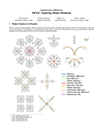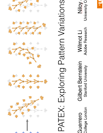PATEX: Exploring Pattern Variations
- Paul Guerrero1
- Gilbert Bernstein2
- Wilmot Li3
- Niloy J. Mitra1
1University College London 2Stanford University 3Adobe Research
SIGGRAPH 2016
Abstract
Patterns play a central role in 2D graphic design. A critical step in the design of patterns is evaluating multiple design alternatives. Exploring these alternatives with existing tools is challenging because most tools force users to work with a single fixed representation of the pattern that encodes a specific set of geometric relationships between pattern elements. However, for most patterns, there are many different interpretations of its regularity that correspond to different design variations. The exponential nature of this variation space makes the problem of finding all variations intractable. We present a method called PATEX to characterize and efficiently identify distinct and valid pattern variations, allowing users to directly navigate the variation space. Technically, we propose a novel linear approximation to handle the complexity of the problem and efficiently enumerate suitable pattern variations under proposed element movements. We also present two pattern editing interfaces that expose the detected pattern variations as suggested edits to the user. We show a diverse collection of pattern edits and variations created with PATEX. The results from our user study indicate that our suggested variations can be useful and inspirational for typical pattern editing tasks.
Bibtex
@article{GuerreroEtAl:PATEX:2016,
title = {{PATEX}: Exploring Pattern Variations},
author = {Paul Guerrero and Gilbert Bernstein and Wilmot Li and Niloy J. Mitra},
year = {2016},
journal = {ACM Trans. Graph.},
volume = {35},
number = {4},
issn = {0730-0301},
pages = {48:1--48:13},
numpages = {13},
doi = {10.1145/2897824.2925950},
}
Acknowledgements
We thank the anonymous reviewers for their comments and constructive suggestions, and the participants of our user study. This work was supported in part by the ERC Starting Grant Smart-Geometry (StG-2013-335373), Marie Curie CIG 303541, and the Open3D Project (EPSRC Grant EP/M013685/1).





